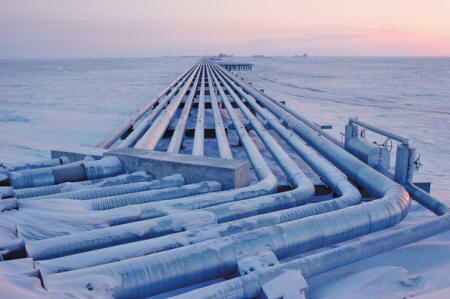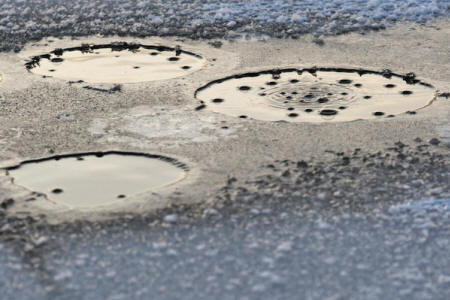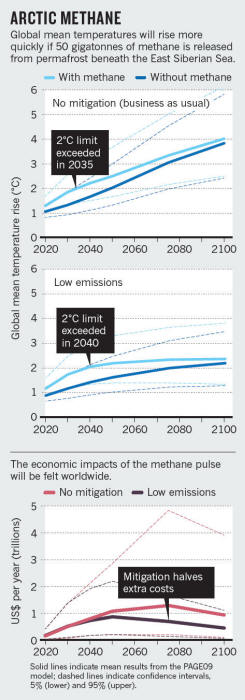|

by Gail Whiteman, Chris Hope and Peter Wadhams
25 July 2013
from
Nature Website

Pipes transport oil
from rigs
on Endicott Island in
Alaska.
Unlike the loss of sea ice, the vulnerability of polar bears and the
rising human population, the economic impacts of a warming Arctic
are being ignored.
Most economic discussion so far assumes that opening up the region
will be beneficial. The Arctic is thought to be home to 30% of the
world's undiscovered gas and 13% of its undiscovered oil, and new
polar shipping routes would increase regional trade. 1, 2
The insurance market Lloyd's of London
estimates that investment in the Arctic could reach US$100 billion
within ten years.3
The costliness of environmental damage from development is
recognized by some, such as Lloyd's 3 and the
French oil giant Total, and the dangers of Arctic oil spills are the
subject of a current panel investigation by the US National Research
Council. What is missing from the equation is a worldwide
perspective on Arctic change.
Economic modeling of the resulting
impacts on the world's climate, in particular, has been scant.
We calculate that the costs of a melting Arctic will be huge,
because the region is pivotal to the functioning of Earth systems
such as oceans and the climate. The release of methane from thawing
permafrost beneath the East Siberian Sea, off northern Russia, alone
comes with an average global price tag of $60 trillion in the
absence of mitigating action - a figure comparable to the size of
the world economy in 2012 (about $70 trillion).
The total cost of Arctic change will be
much higher.

Bubbles of methane
emerge
from sediments below
a frozen Alaskan lake.
Much of the cost will be borne by developing countries, which will
face extreme weather, poorer health and lower agricultural
production as Arctic warming affects climate.
All nations will be affected, not just
those in the far north, and all should be concerned about changes
occurring in this region. More modeling is needed to understand
which regions and parts of the world economy will be most
vulnerable.
Economic time bomb
As the amount of Arctic sea ice declines at an unprecedented rate,4,
5 the thawing of offshore permafrost releases methane.
A 50-gigatonne (Gt) reservoir of
methane, stored in the form of hydrates, exists on the East Siberian
Arctic Shelf. It is likely to be emitted as the seabed warms, either
steadily over 50 years or suddenly.6
Higher methane concentrations in the
atmosphere will accelerate global warming and hasten local changes
in the Arctic, speeding up sea-ice retreat, reducing the reflection
of solar energy and accelerating the melting of the Greenland ice
sheet. The ramifications will be felt far from the poles.
To quantify the effects of Arctic methane release on the global
economy, we used
PAGE09 model. This integrated
assessment model calculates the impacts of climate change and the
costs of mitigation and adaptation measures.
An earlier version of the PAGE model was
used in the UK government's 2006 Stern Review on the Economics of
Climate Change to evaluate the effect of extra greenhouse-gas
emissions on sea level, temperature, flood risks, health and extreme
weather while taking account of uncertainty.7
The model assesses how the net present
value of climate effects varies with each tonne of carbon dioxide
emitted or saved.
We ran the PAGE09 model 10,000 times to calculate confidence
intervals and to assess the range of risks arising from climate
change until the year 2200, taking into account sea-level changes,
economic and non-economic sectors and discontinuities such as the
melting of the Greenland and West Antarctic ice sheets (see
Supplementary Information).
We superposed a decade-long pulse of 50
Gt of methane, released into the atmosphere between 2015 and 2025,
on two standard emissions scenarios.
increasing emissions of CO2
and other greenhouse gases with no mitigation
action (the scenario used by the Intergovernmental Panel
on Climate Change Special Report on Emissions Scenarios
A1B).
We also explored the impacts of later,
longer-lasting or smaller pulses of methane.
There is a steep global price tag
attached to physical changes in the Arctic.
In all of these cases there is a steep
global price tag attached to physical changes in the Arctic,
notwithstanding the short-term economic gains for Arctic nations and
some industries.
The methane pulse will bring forward by 15-35 years the average date
at which the global mean temperature rise exceeds 2°C above
pre-industrial levels - to 2035 for the business-as-usual scenario
and to 2040 for the low-emissions case (see 'Arctic methane').
This will lead to an extra $60 trillion
(net present value) of mean climate-change impacts for the scenario
with no mitigation, or 15% of the mean total predicted cost of
climate-change impacts (about $400 trillion). In the low-emissions
case, the mean net present value of global climate-change impacts is
$82 trillion without the methane release; with the pulse, an extra
$37 trillion, or 45% is added (see Supplementary Information).
These costs remain the same irrespective
of whether the methane emission is delayed by up to 20 years,
kicking in at 2035 rather than 2015, or stretched out over two or
three decades, rather than one.
A pulse of 25 Gt of methane has half the
impact of a 50 Gt pulse.
The economic consequences will be distributed around the globe, but
the modeling shows that about 80% of them will occur in the poorer
economies of Africa, Asia and South America.
The extra methane magnifies flooding of
low-lying areas, extreme heat stress, droughts and storms.
Global problem
The full impacts of a warming Arctic, including, for example, ocean
acidification and altered ocean and atmospheric circulation, will be
much greater than our cost estimate for methane release alone.
To find out the actual cost, better models are needed to incorporate
feedbacks that are not included in PAGE09, such as linking the
extent of Arctic ice to increases in Arctic mean temperature, global
sea-level rise and ocean acidification, as well as including
estimates of the economic costs and benefits of shipping.

Oil-and-gas development in the Arctic
should also, for example, take into account the impacts of black
carbon, which absorbs solar radiation and speeds up ice melt, from
shipping and gas flaring.
Splitting global economic impact figures into countries and industry
sectors would raise awareness of specific risks, including the
flooding of small-island states or coastal cities such as New York
by rising seas. Mid-latitude economies such as those in Europe and
the United States could be threatened, for example, by a suggested
link between sea-ice retreat and the strength and position of the
jet stream,8 bringing extreme winter and spring
weather.
Unusual positioning of the jet stream
over the Atlantic is thought to have caused this year's protracted
cold spell in Europe.
Such integrated analyses of Arctic change must enter global economic
discussions. But neither the World Economic Forum (WEF) in
its Global Risk Report nor
the International Monetary Fund in
its World Economic Outlook 9 recognizes the
potential economic threat from changes in the Arctic.
In 2012, noting that the far north is increasing in strategic
importance and citing the need for informal dialogue among world
leaders, the WEF launched its Global Agenda Council on the Arctic.
This is welcome but more action is needed. The WEF should kick-start
investment in rigorous economic modeling.
It must ask world leaders to consider
the economic time bomb beyond short-term gains from shipping and
extraction.
The WEF should also encourage innovative adaptation and mitigation
plans. It will be difficult - perhaps impossible - to avoid large
methane releases in the East Siberian Sea without major reductions
in global emissions of CO2. Given that the methane
originates in local seabed warming, then reducing black carbon
deposits on snow and ice might buy some precious time.10
But unknown factors could also mean that
our impact estimates are conservative. Methane emerging in a sudden
burst could linger for longer in the atmosphere, and trigger more
rapid temperature changes than if the gas were released gradually.
Arctic science is a strategic asset for human economies, because the
region drives critical effects in our biophysical, political and
economic systems. Without this recognition, world leaders and
economists will miss the big picture.
References
-
Gautier, D. L. et al. Science 324, 11751179 (2009) -
Assessment of Undiscovered Oil and Gas
in the Arctic
-
Smith, L. C. & Stephenson, S. R. Proc. Natl Acad. Sci. USA
110, E1191E1195 (2013) -
New Trans-Arctic shipping routes
navigable by midcentury
-
Emmerson, C. & Lahn, G. -
Arctic Opening: Opportunity and Risk
in the High North (Chatham House-Lloyd's, 2012)
-
Wadhams, P. AMBIO 41, 2333 (2012) -
Arctic Ice Cover, Ice Thickness and
Tipping Points
-
Maslowski, W., Kinney, J. C., Higgins, M. & Roberts, A. Annu.
Rev. Earth Planet. Sci. 40, 625654 (2012) -
The Future of Arctic Sea Ice
-
Shakhova, N. E, Alekseev, V. A, & Semiletov, I. P. Doklady
Earth Sci. 430, 190193 (2010) -
Predicted methane emission on the East
Siberian shelf
-
Hope, C. Clim. Change 117, 531543 (2013) -
Critical issues for the calculation of
the social cost of CO2: why the estimates from PAGE09 are
higher than those from PAGE2002
-
Francis, J. A. & Vavrus, S. J. Geophys. Res. Lett. 39,
L06801 (2012) -
Evidence linking Arctic amplification
to extreme weather in mid-latitudes
-
International Monetary Fund. World
Economic Outlook (IMF, 2013).
-
Shindell, D. et al. Science 335, 183189 (2012) -
Simultaneously Mitigating Near-Term
Climate Change and Improving Human Health and Food Security
|



